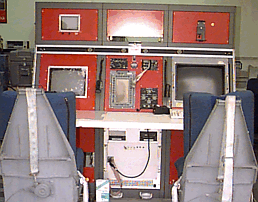
RADS system deployed on Coast Guard C-130.
|
Radar Acquisition and Display System Summary
The Radar Acquisition and Display System (RADS) is a moveable system designed to record
and display data from a research Doppler radar with polarization diversity. Physically, the unit
consists of a 6U VME chassis as well as an external color monitor, keyboard and mouse.
Connection to the radar is made at four levels: radar timing signals (trigger, polarization control
and range gates), receiver (in-phase and quadrature video, log output from both horizontally and
vertically polarized receivers), synchro for monitoring azimuth and elevation, and ethernet for
communicating with a resident radar computer that controls the antenna.
RADS contains the following VME cards: Radar Timing Generator (RTG), SPARC-based CPU,
DSP (Digital Signal Processing) card containing four TMS320C40 DSP chips, a four-channel 20
MHz A/D card with 1 MB buffer memory, and a synchro-digital card. The chassis also contains
a hard disk drive, a CD-ROM drive, and two 8mm cartridge tape drives. Solaris 2.5, a version of
UNIX, is run on the CPU; no operating system is used on the DSP card.
The operator controls RADS through a GUI (Graphical User Interface) window on the color
monitor. All radar parameters may be viewed, and certain subsets of parameters may be selected
to be shown simultaneously on the screen. Thus if one is in Pulse-Pair mode, only those
parameters that are pertinent to that mode, and that change frequently in that mode, will be
displayed. In addition, because of the large number of parameters (> 80), they are grouped by
primary function (timing, calibration, scanning, transmitter, receiver, data processing and
housekeeping), and may be displayed in groups this way as well. The operator may select
functions through "buttons" on the GUI, and in this way controls processing and recording.
Plots, such as Doppler spectrum or delta-k spectrum, as well as areal displays, such as PPI, RHI
or B-scan are shown on the color monitor. Numerous fields may be selected for display in the
areal formats, depending on the processing mode that has been selected. Since all processing
modes are programmed, it is relatively easy to add additional modes. The following modes have
been implemented: time-series, power spectrum, pulse-pair, and pulse-pair with differential
phase and HV correlation. There are four variations on this last mode, depending on the
algorithm used to calculate HV correlation, and the fields desired.
The RTG generates all timing parameters under program control and can generate pairs of pulses
for use with the pulse-pair algorithm. Therefore all timing parameters, such as intra- and inter-pair spacing and range gate delay, spacing and number are completely programmable within the
confines of the radar being driven and the processing and recording speed of RADS. The speed
limitations of RADS depends on the mode that is being used. In general, modes such as time-series and power spectrum that have little or no data compression, are limited by recording
speed. Modes such as pulse-pair that have much data compression are limited by processing
speed.
Specifications
| Hardware/Software |
|---|
| Chassis: |
VME, 12 slots |
| Processor: |
SPARC 5 with 64 MB memory, SCSI interface, 2 S-bus slots, ethernet |
| Display: |
1280 x 1024 color monitor |
| Analog/Digital: |
4-channel (in-phase, quadrature, log vertical, log horizontal), 12-bit, 20
MHz with 1 MB swinging buffer memory |
| Digital Signal
Processing: |
4 TMS320C40 DSP chips, 1 MB local memory, 2 MB global memory |
| Synchro/Digital: |
2-channel (azimuth & elevation), 14-bit |
| Radar Timing
Generator: |
generates pulse-pair triggers and pre-triggers, range gates, transmit and
receive polarization control, other timing signals under program control |
| Operating System: |
Solaris 2.5 |
| Maximum number of
range gates: |
mode dependent, 512 in pulse-pair mode |
References
Campbell, W. Carroll and J. Gibson, 1997: A Programmable Real-time Data
Processing and Display System for the NOAA/ETL Doppler Radars,
Proceedings of the 28th Conference on Radar Meteorology, Austin TX,
American Meteorology Society.
|